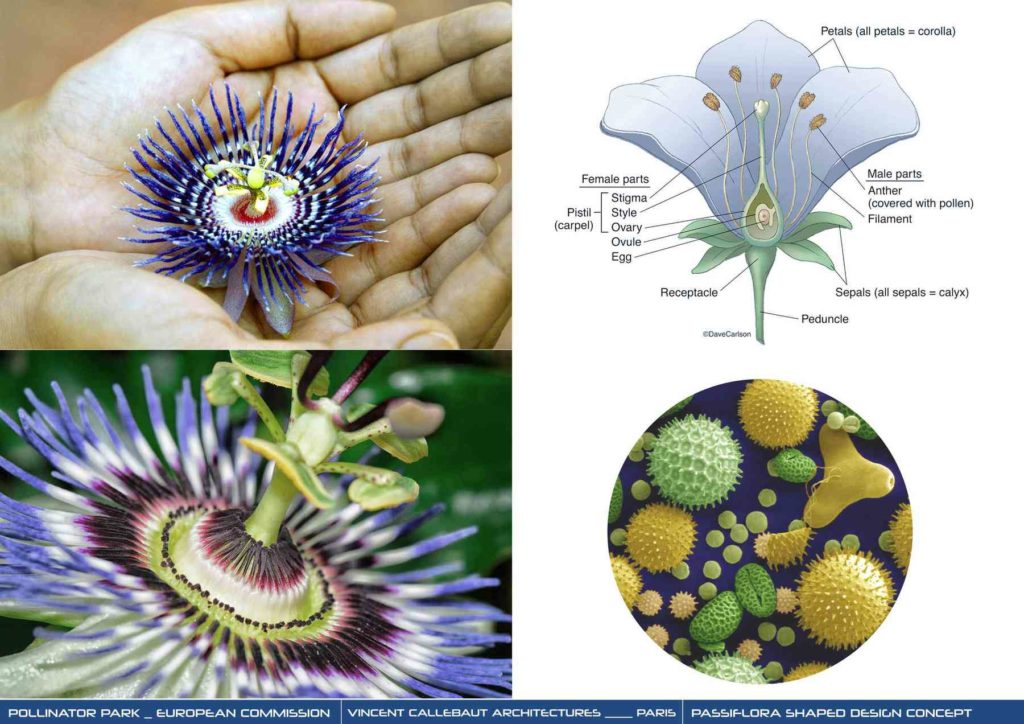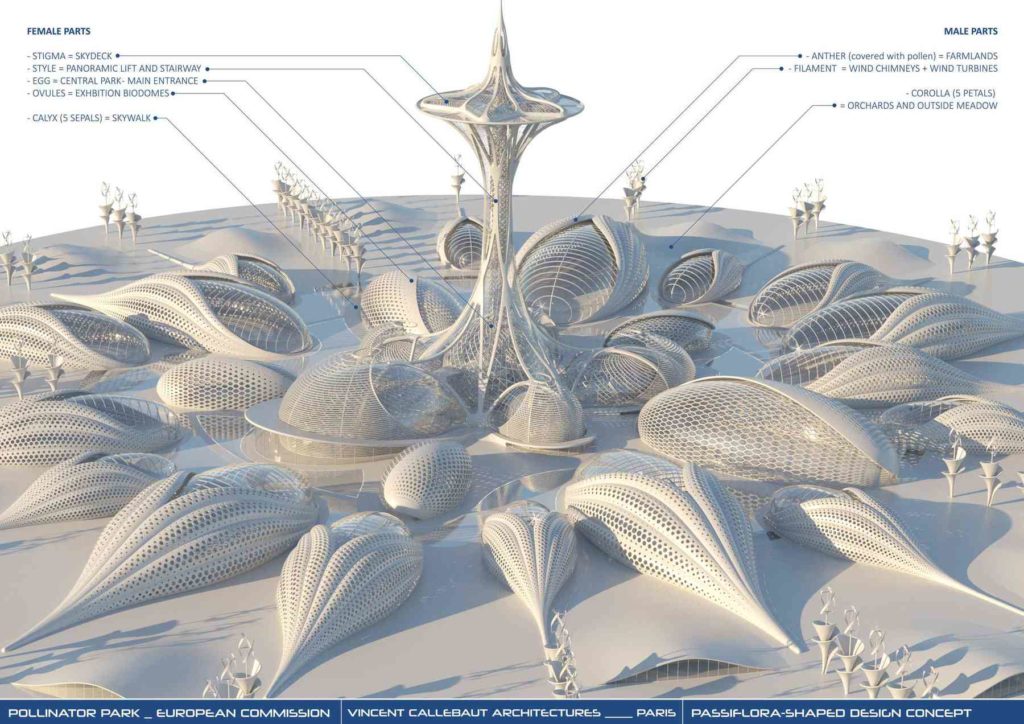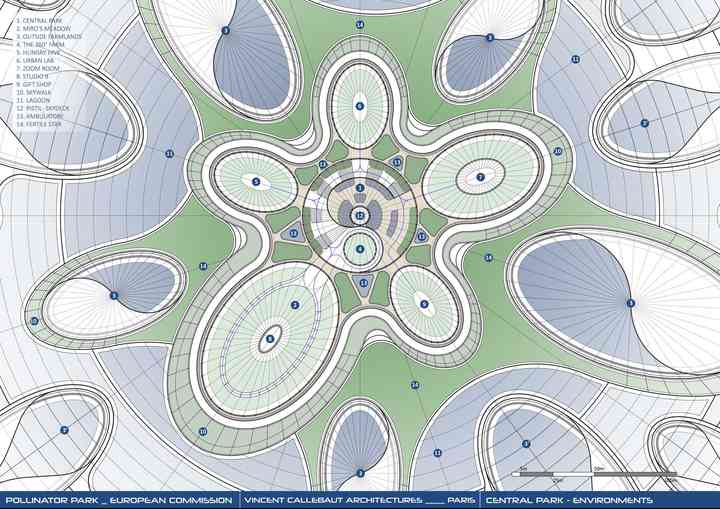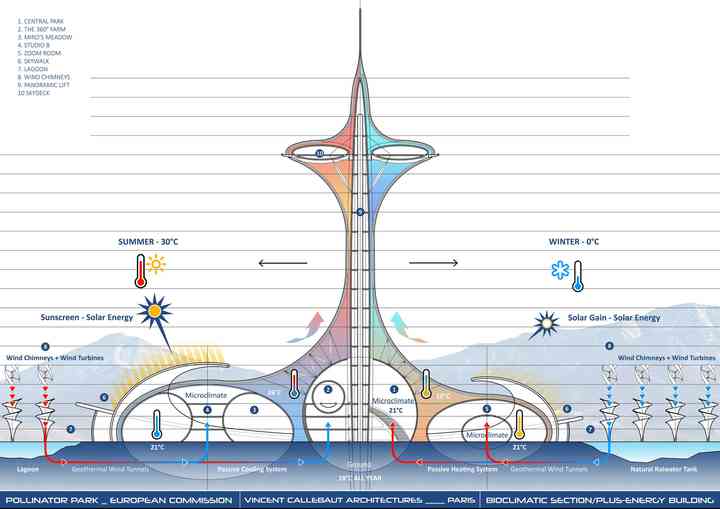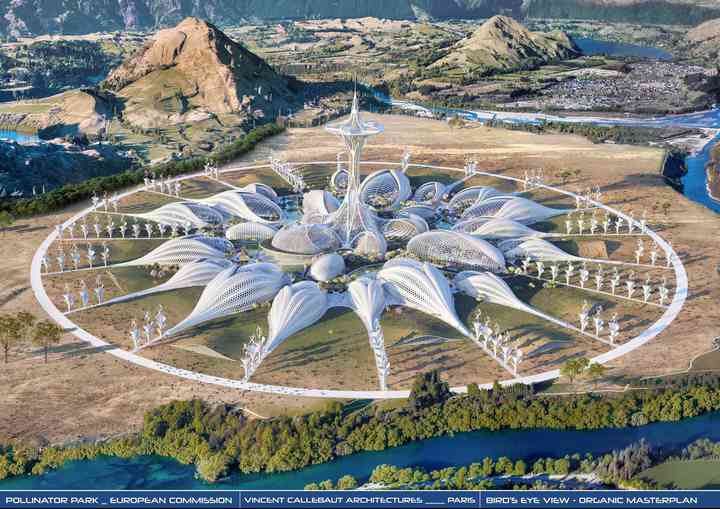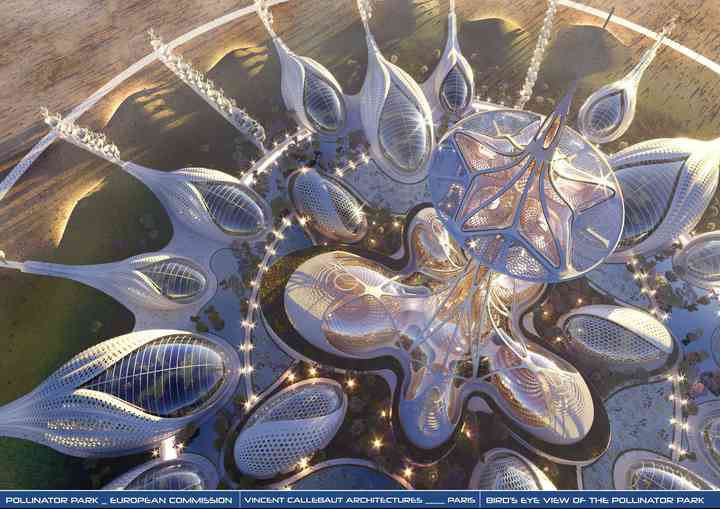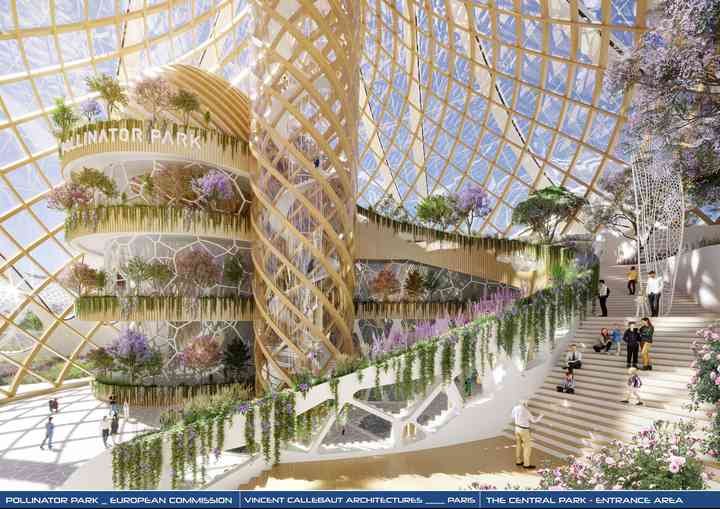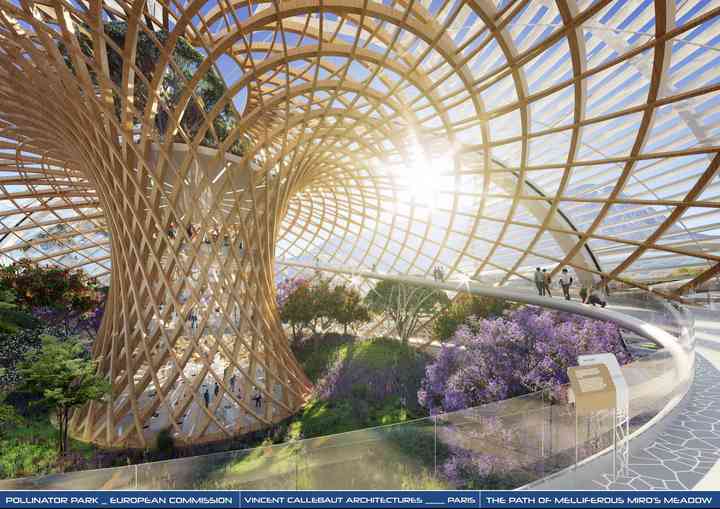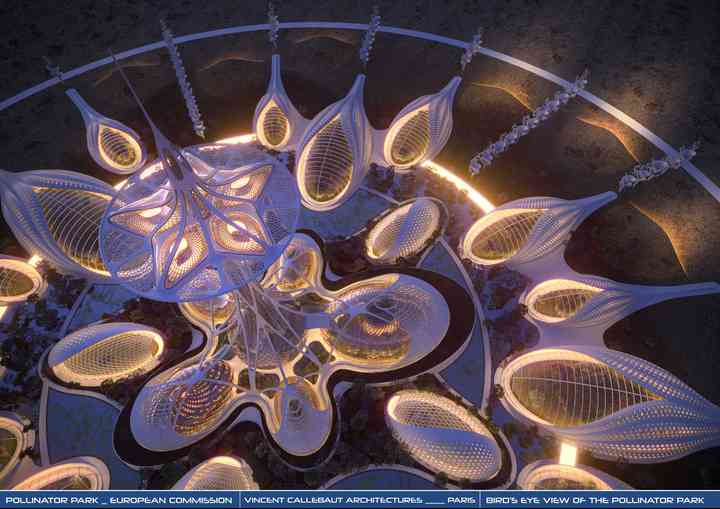The Architecture of Pollinator Park
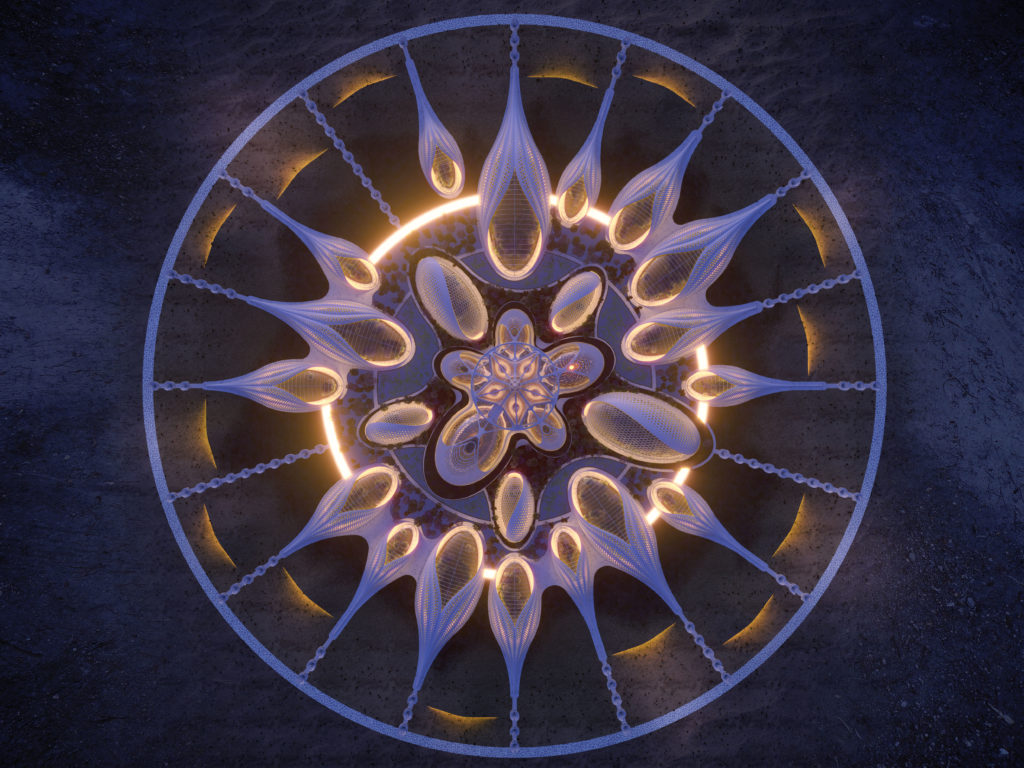
During our concept phase we had created various mood boards to define a look and feel for Pollinator Park. In several of them the work of Vincent Callebaut was added as inspiration. This caught the eye of the commission, after which a first meeting was set up to discuss our collaboration. And a very inspiring collaboration it would become indeed…
When Story meets Technology, meets Architecture...
Vincent Callebaut took our initial vision, story and concepts and expanded our virtual universe to a higher level. Here is an overview of his contribution…
ARCHITECTURAL NOTICE, BY VINCENT CALLEBAUT ARCHITECTURES
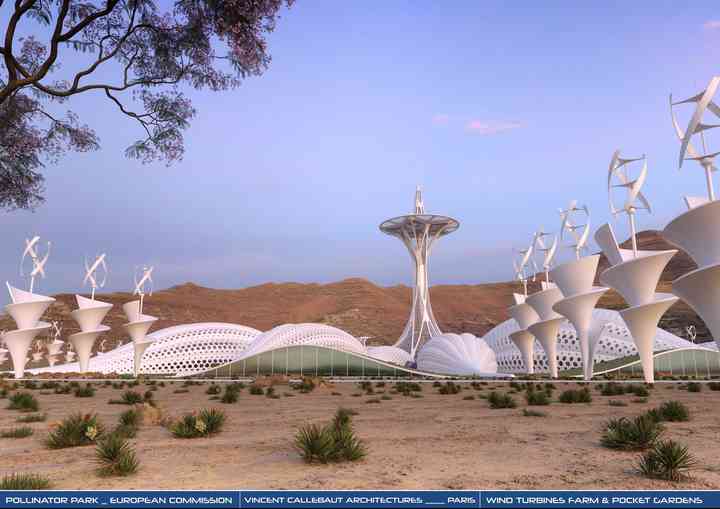
OBJECTIVES: PROTECT ECOSYSTEMS IN ORDER TO HALT THE DECLINE OF POLLINATORS
Bees, bumblebees, butterflies, ants, hummingbirds, bats, ladybugs, beetles. A pollinator is an animal which, while moving around, carries pollen grains from the male anthers to the female stigma of flowers. In doing so, it contributes to the fertilization of the female gametes in the flowerovum as the pollen grains allow plants to reproduce.
The amount and diversity of pollinators strongly influence plant biodiversity and vice versa. The loss of biodiversity in pollinators now threatens the sustainability of the plant communities that feed us.
Endangered by green chemistry and the toxicity of plant protection products, a large part of pollinator populations are victims of a demographic collapse which affects this ecosystem service, which is considered to be major and precious for the global human diet: pollination, in the field of agriculture, animal husbandry, and even forestry.
As of 2020, pollinators are seriously threatened with an extinction rate that is “100 to 1,000 times higher than normal”, according to the UN.
The reproduction of more than 90% of the world’s species of flowering plants depends on these pollinating animals which have suffered the destruction of their natural habitats, the loss of resources, the explosion of pesticides, and the climatic disturbance that is shifting the seasons. All this due to human activity.
In 1999, more than 20 years ago, during the Convention on Biological Diversity (Declaration on Pollinators, São Paulo), the UN States had already recognized pollinators as “key species” providing ecosystem services necessary to humans as they helped maintain biodiversity, agricultural productivity, and the human economy.
Most of the world’s agriculture therefore depends on pollinators. Insects are often considered to be of little importance or even as harmful or troublesome species to be eliminated. And yet, 35% of what we eat depends on pollination by insects including coffee, cocoa, and spices. The service provided by bees and main pollinators has been estimated by INRA at 153 billion euros per year. According to a report published in “Nature” in 2016, the extinction of pollinators threatens 1.4 billion jobs worldwide: 1/5 of the population.
In early June 2018, the European Commission proposed “the very first European Union (EU) initiative to halt the decline of wild pollinating insects”, which is based on monitoring and coordination of actions aimed at “remedying the social and economic consequences of the decrease in pollinating insects”. Raising awareness among children and European citizens of measures to tackle this decline is the major objective of Pollinator Park.
SOLUTIONS: POLLINATOR PARK, AN OASIS OF SUSTAINABLE FOOD PRODUCTION WITH POLLINATORS AS THE MAIN SOURCE
In order to preserve and restore the biodiversity of pollinating fauna, Pollinator Park is a true demonstrator on a real scale. From the Miro’s Meadow to the Hungry Hive, via the Urban Lab and the Zoom Room, it promotes the noble role of the farming profession. It shows good practices in pollinator preservation on multiple levels: territorial land-use, agricultural, forest, and urban.
The solutions are numerous and often simple to implement:
1. Territorialization which preserves ecological corridors: restoration of forest edges, fallow fields, pastures, and melliferous meadows, as well as the preservation of multi-layer herbaceous hedges with tall trees and native vegetation along agricultural fields and country roads;
2. Less mono-cultivated, chemical, and toxic agriculture. More reasoned agriculture, prohibiting the spreading of pesticides, fungicides, and insecticides. The agriculture of the future aims at the intensive development of organic farming, permaculture, and agroforestry, three biodiversity-oriented practices;
3. Urbanization fighting against the artificialization of soils: based on the establishment of green and blue networks of natural habitats more favorable to pollinators and the banning of phytosanitary products in public parks and private gardens. This fertile urbanization can be achieved by the establishment of nesting substrates (for example suitable soils, cavities in trees, or building facades) as well as by the deployment of floral resources. These can be increased by creating urban forests, revegetating schoolyards, and building urban farms as well as apartment buildings and green, edible offices covered with vegetable gardens and orchards.
TOOLS: AN ARCHITECTURAL CLUSTER OF BIOMIMETIC BOTANICAL GREENHOUSES BUILT WITH MASS TIMBER AND POSITIVE ENERGY
Ecology is the “raw material” of architecture in the 21st century and this is the leitmotif of Pollinator Park. Ode to nature, its organic design is directly bioinspired by pollination, the sexual reproduction method of plants. It thus poetically draws its structure from that of a blooming flower.
Central Park symbolizes female organs and unites all of the park’s exhibition spaces. From bottom to top, the ovaries constitute the educational spiral-structured biodomes, the style accommodates a panoramic glass elevator and a Chambord double staircase, while the stigma is transformed into an observation platform flourishing in the sky.
From this epicenter, the Farmlands – biodomes with honeycomb structures, ribbed leaves, or even voronoi – are dedicated to the agriculture of the future. They are spatially organized in a radial plane. Their striated and voluptuous geometries are inspired by anthers, the male organs of a flower covered with pollen grains.
In terms of landscape, these botanical greenhouses for exhibition and agricultural production are protected by a huge perianth. This consists of a 5-sepal calyx around Central Park and a 5-petal corolla around the Farmlands.
The organic architecture of Pollinator Park stimulates the natural flow of the visitor experience where biomorphic architecture and lush nature merge into a unique ecosystem exhibiting how nature creates ecosystems. In each environment, pollinator hotels are integrated into the playful architecture because Pollinator Park is, first and foremost, their home!
Ode to the circular economy and renewable energies, all greenhouses are designed from light frames in cross-laminated timber (CLT) and recycled or recyclable biosourced materials distributed in virtuous loops and short circuits.
The mass timber biodomes are covered with photovoltaic and thermal solar shields in order to become positive energy buildings producing more energy than they consume. These sun shields filter the sun’s rays and create a perfect balance between light and shadow.
In order to create this positive balance, a field of wind chimneys and wind turbines is radially implanted in the landscape. This wind farm also makes it possible to use the energy of the wind and take advantage of the ground’s thermal inertia to naturally bioclimatize the spaces inside the greenhouses. In fact, the wind chimneys use geothermal energy to cool the greenhouses in summer and heat them in winter, the temperature of the ground resting at 18 degrees Celsius all year round.
In terms of construction and energy, Pollinator Park is therefore a real carbon sink and an exemplary project in terms of ecological engineering.
Within this biomimetic oasis inspired by the shapes, structures, and feedback loops of natural ecosystems, the scenographic experience focuses on the correlation between pollinators and food production. This immersive scenography aims to sensitize and poetically move Europeans, young and old, to better teach them how to protect their natural fauna and flora heritage and consequently their health.
Find more images and information about Vincent Callebaut:
https://vincent.callebaut.org/object/210323_pollinatorpark/pollinatorpark/projects
More about Pollinator Park
- Pollinator Park
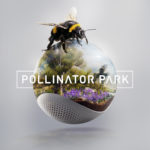 What does it take for mankind to start caring for animal species on the verge of extinction? Actual extinction? Or…… Read more: Pollinator Park
What does it take for mankind to start caring for animal species on the verge of extinction? Actual extinction? Or…… Read more: Pollinator Park - Pollinator Park – Virtual Launch Show
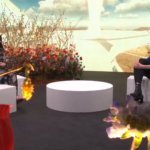 March 23rd 2021 – Today is the official launch of Pollinator Park. We’ve been working on this beautiful project for… Read more: Pollinator Park – Virtual Launch Show
March 23rd 2021 – Today is the official launch of Pollinator Park. We’ve been working on this beautiful project for… Read more: Pollinator Park – Virtual Launch Show - The Story of Beatrice Kukac
 How one woman’s passion project became a beacon of hope in a pollinator-deprived world.
How one woman’s passion project became a beacon of hope in a pollinator-deprived world. - The Concept Art of Pollinator Park
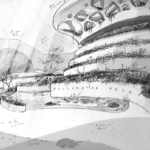 With a few diagrams and sketches, and a bunch of mood board images we reached out to Bart Lommelen (Fixion)… Read more: The Concept Art of Pollinator Park
With a few diagrams and sketches, and a bunch of mood board images we reached out to Bart Lommelen (Fixion)… Read more: The Concept Art of Pollinator Park - The Architecture of Pollinator Park
 During our concept phase we had created various mood boards to define a look and feel for Pollinator Park. In… Read more: The Architecture of Pollinator Park
During our concept phase we had created various mood boards to define a look and feel for Pollinator Park. In… Read more: The Architecture of Pollinator Park - Press Release – World Bee Day
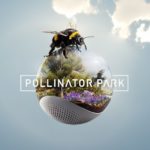 Pollinator Park Step into a beautiful virtual reality about the ugly future we face without pollinating insects
Pollinator Park Step into a beautiful virtual reality about the ugly future we face without pollinating insects - Belgian Game Awards 2021
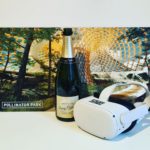 Proud to announce that Pollinator Park is Winner in the category Best non-entertainment title of the year.
Proud to announce that Pollinator Park is Winner in the category Best non-entertainment title of the year. - Een wereld van verschil…
 Hoe zal de aarde eruitzien zonder wilde bijen en andere bestuivers? In de achtdelige online videoreeks ‘Een wereld van verschil’… Read more: Een wereld van verschil…
Hoe zal de aarde eruitzien zonder wilde bijen en andere bestuivers? In de achtdelige online videoreeks ‘Een wereld van verschil’… Read more: Een wereld van verschil… - Host Pollinator Park at your event
 You would like to feature Pollinator Park at your event, but don’t know where to start? Most users don’t know… Read more: Host Pollinator Park at your event
You would like to feature Pollinator Park at your event, but don’t know where to start? Most users don’t know… Read more: Host Pollinator Park at your event

